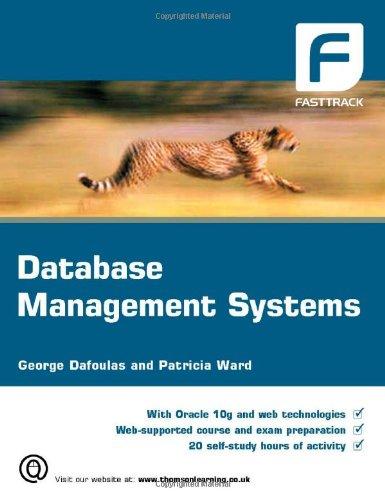Question
Part 1: Remote access to mdb-lookup-cs3157 using netcat (100 points) --------------------------------------------------------------------- (a) You learned in class how to use a named pipe (aka FIFO) and
Part 1: Remote access to mdb-lookup-cs3157 using netcat (100 points) ---------------------------------------------------------------------
(a)
You learned in class how to use a named pipe (aka FIFO) and the netcat (nc) program to turn mdb-lookup-cs3157 into a network server.
mkfifo mypipe cat mypipe | nc -l some_port_num | /some_path/mdb-lookup-cs3157 > mypipe
Write a shell script that executes the pipeline.
- The name of the script is "mdb-lookup-server-nc.sh"
- A shell script starts with the following line (the '#' is the 1st character without any leading space):
#!/bin/sh
And the line must be the VERY FIRST LINE in the script.
- You must make the file executable using "chmod" command.
- The script takes one parameter, port number, on which nc will listen.
- The script should create a named pipe named mypipe-
- See section 3.4 in the Bash Reference Manual (http://www.gnu.org/software/bash/manual/bashref.html) for how to refer to the arguments and the process ID from your script.
- Because the named pipe gets removed only at the end of the script, if you quit out of the script by hitting Ctrl-C while it's running, the FIFO will not get removed. This is ok. You can manually clean up the FIFOs in the directory. If this annoys you, you can optionally add the following lines to your script after the first line:
on_ctrl_c() { echo "Ignoring Ctrl-C" }
# Call on_ctrl_c() when the interrupt signal is received. # The interrupt signal is sent when you press Ctrl-C. trap on_ctrl_c INT
(b)
Here is a program that runs the shell script from (a) as a child process (mdb-lookup-server-nc-1.c):
#include
static void die(const char *s) { perror(s); exit(1); }
int main(int argc, char **argv) { if (argc != 2) { fprintf(stderr, "usage: %s
pid_t pid = fork(); if (pid < 0) { die("fork failed"); } else if (pid == 0) { // child process fprintf(stderr, "[pid=%d] ", (int)getpid()); fprintf(stderr, "mdb-lookup-server started on port %s ", argv[1]); execl("./mdb-lookup-server-nc.sh", "mdb-lookup-server-nc.sh", argv[1], (char *)0); die("execl failed"); } else { // parent process if (waitpid(pid, NULL, // no status 0) // no options != pid) die("waitpid failed"); fprintf(stderr, "[pid=%d] ", (int)pid); fprintf(stderr, "mdb-lookup-server terminated "); }
return 0; }
Study this program and the man pages for the system calls used in it. Run it to make sure it works with your shell script from (a). Make sure you understand how everything works.
While this program is running, run the following command from another terminal window logged into the same machine:
ps ajxfww
Find the process tree that contains ALL ancestors and children of this program, and include it in your README.txt.
Make sure you understand the process relationships in that tree. Identify the files that are shell scripts and list them in your README.txt.
(c)
Write an improved version: mdb-lookup-server-nc-2.c
mdb-lookup-server-nc-1.c from (b) forked once, exec'ed the script, waited until it's done, and then exited.
mdb-lookup-server-nc-2.c will do the following:
- It has a loop in which it displays a prompt, "port number: ". It reads the port number typed in by the user and then fork/exec the script from (a) using that port number. It also prints out a message stating that an instance of mdb-lookup-server has started. The message should include the child's process ID and the port number on which it's listening.
- Hitting ENTER on the prompt should simply display another prompt.
- On every iteration, before it displays a prompt, it should check if any of the child processes have terminated. It should display the process IDs of all mdb-lookup-server processes that have terminated since the last prompt was displayed, along with messages saying that they have terminated. For this, you need to use the non-blocking version of waitpid() system call. Here is how you use it:
pid = waitpid( (pid_t) -1, NULL, WNOHANG);
- Use Ctrl-C to quit.
Step by Step Solution
There are 3 Steps involved in it
Step: 1

Get Instant Access to Expert-Tailored Solutions
See step-by-step solutions with expert insights and AI powered tools for academic success
Step: 2

Step: 3

Ace Your Homework with AI
Get the answers you need in no time with our AI-driven, step-by-step assistance
Get Started


